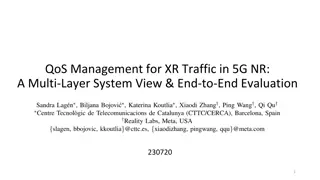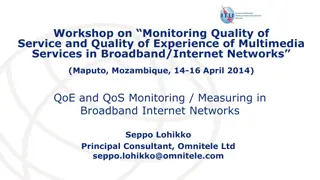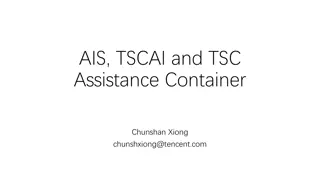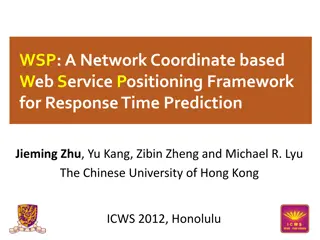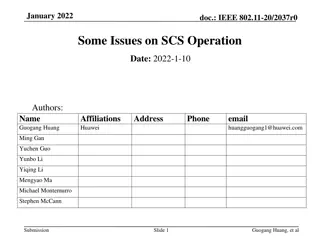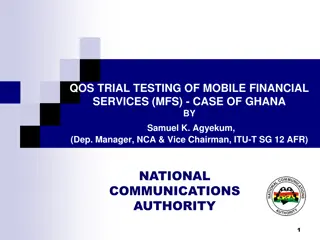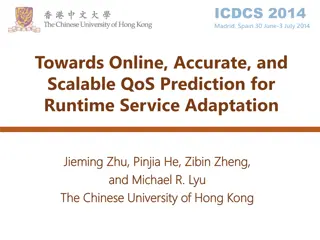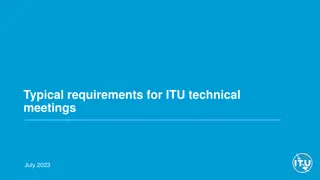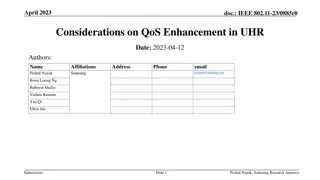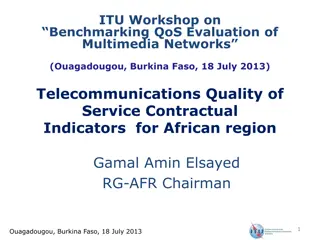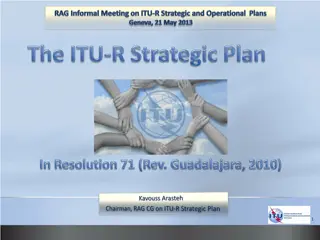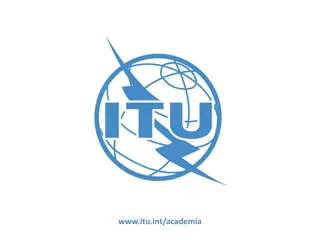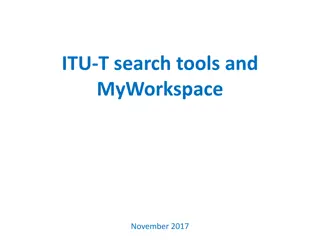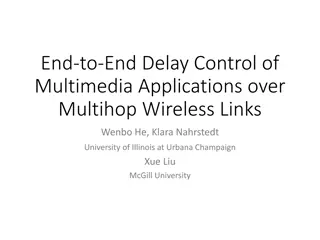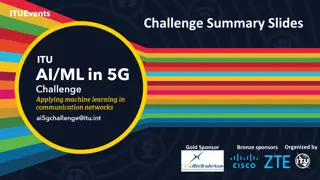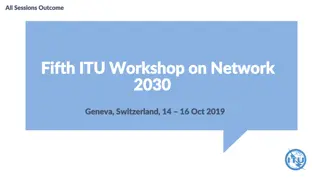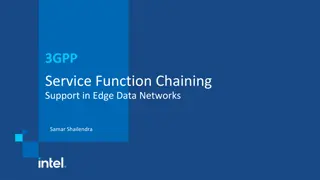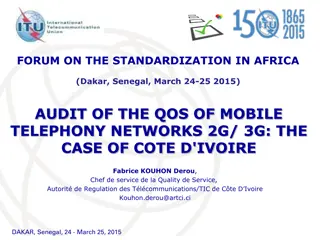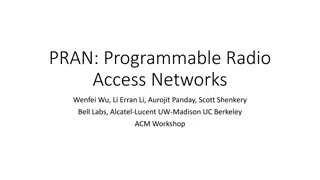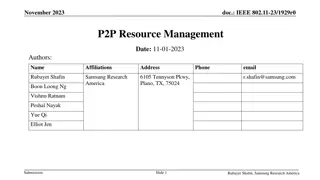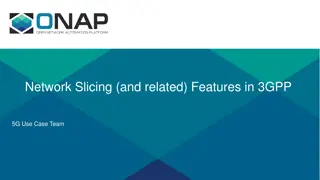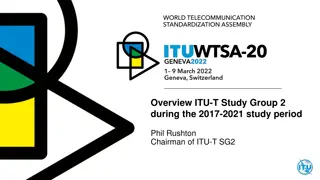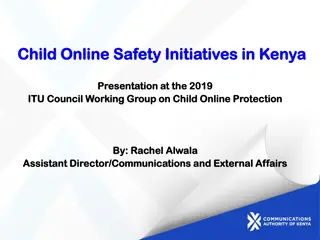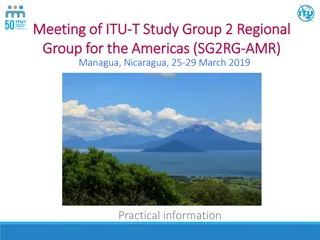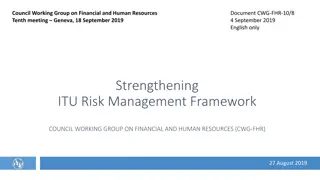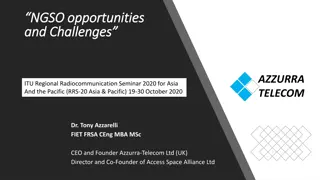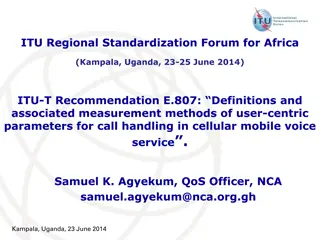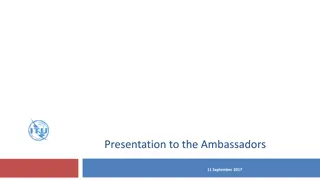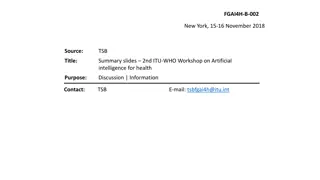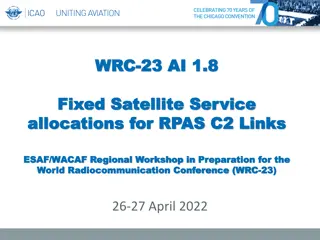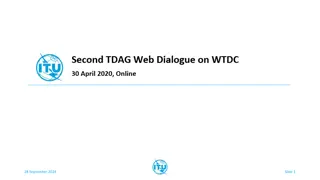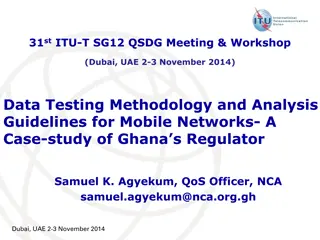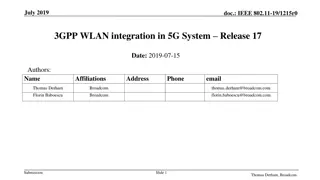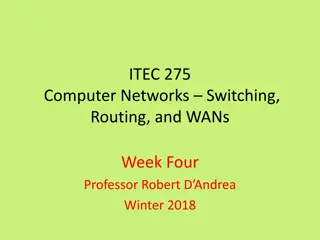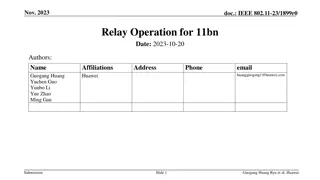Introduction to ITU-T G.1028: End-to-End QoS for VoLTE on 4G Networks
This overview covers the journey and development of ITU-T G.1028, focusing on end-to-end quality of service (QoS) for Voice over LTE (VoLTE) on 4G networks. It details the background, key milestones, essential elements of VoLTE services, optional mechanisms considered, QoS classifications, and call cases covered in the standard.
Download Presentation

Please find below an Image/Link to download the presentation.
The content on the website is provided AS IS for your information and personal use only. It may not be sold, licensed, or shared on other websites without obtaining consent from the author. Download presentation by click this link. If you encounter any issues during the download, it is possible that the publisher has removed the file from their server.
E N D
Presentation Transcript
ITU Workshop on QoS and QoE of Multimedia Applications and Services Haarlem, The Netherlands 9-11 May 2016 Discovery of the new Recommendation ITU-T G.1028: End-to-end QoS for voice on Mobile networks 4G (VoLTE) Vincent BARRIAC, R&D, Orange Labs, Vincent.barriac@orange.com
Brief Reminder G.1028 Is the number assigned after its approval further the Project of Recommendation previously known as "G.VoLTE . Three Years span between the idea and the adoption March 2013: proposal for Launching a study question (Contributions C 074 and 076) and Acceptance for inclusion into the Program of the question 11/12 ("Performance interworking and traffic management for Next Generation Networks") November 2013: First items of shared Knowledge (Contribution C 127) and decision to launch drafting G.VoLTE September 2014: First version of G.VoLTE (Contribution C 189) May 2015: Second Version of G.VoLTE (Contribution C 241) January 2016: Submission of G.VoLTE for consent of the Study Group 12 (contribution C 288, evolved to TD 873 rev 1 after session amendments and entry In the Accelerated Approval Procedure (AAP) 1-28 February 2016: Last Call for Comments (1 Comment received from Ericsson) 6 April 2016: adoption of G.1028 A lot of external standards ITU-T are referred In G.1028: 3GPP: Definitions and Specifications of mobile networks and services IETF: Associated IMS protocol aspects for VOLTE services GSMA: Definition of the VoLTE service from the mobile operator standpoint
Basic Notions of the VoLTE service Chapters 6 and 7 The VoLTE presupposes the use of the following elements 4G access network (E-UTRAN) Compatible terminals Core Network associated to 4G (EPC) and connected to e-UTRAN by an eNodeB IMS Platform and use of the SIP Signalling Protocol Interconnection with the Circuit Switch world (2G, 3G, PSTN)
Basic Notions of the VoLTE service (continued) Chapters 6 and 7 The mechanisms considered as optional but taken into consideration in G.1028: RoHC TTI bundling DTX, DRX SPS SIP Preconditions Delay budget 100Ms Packet loss budget 10-2 QCI GBR Priority Example Of Service Classification Of QOS (Use Of QCI) 1 Yes 2 Voice 5 for SIP 5 Non 1 100Ms IMS signaling 10-6 1 for Voice in real time Audio Coding in AMR or AMR WB, with support of TrFO Functionalities for future versions of G.1028 SRVCC VoWiFi ViLTE ?
Call Cases Considered In G.1028 Chapters 7.1 to 7.4 LTE-LTE -With and Without Roaming LTE-3G LTE-RTC
Identification of Main Degradations of Perceived Quality Chapter 8 Annex 1 Family 1: Difficulties related to service delivery Registration (IMS/SIP) Call Establishment Call End (moreor less desired) Family 2: Difficulties related to the Audio Contents of the Service (Similar To the other mobile services) Frequency Contents (Coding, Distortions) Interruptions, Cuts Delay, Difficulties of interactivity Background noise Impact of the use of VoLTE on the other elements : not dealt within G.1028 QoS of data services Lifetime of the Battery
Identification of Main Degradations of Perceived Quality Chapter 8
Selection of QoS indicators (1/2) Name Definition Corersponding IP Metric KPI related to IMS and based on P-CSCF counters Registration success rate Rate of successful registration attempts in the VoLTE service. Chapter 9 Equivalent Registration Attempt (IRA) ratio (see IETF RFC 6076) to 1 Ineffective Service availability End to end service availability in terms of capacity to establish calls from, and to, a VoLTE customer. Network Efficiency Ratio (NER) Measures the ability of network, from the service platform point of view, to deliver calls to the VoLTE customer, For the SIP Protocol, NER = SEER (seeIETF RFC 6076) Post Dialing Delay (PDD) Time interval (in seconds) between the end of dialling by the caller and the reception back by him of the appropriate ringing tone or recorded announcement. SIP session set up time Interval message (with SDP) and ACK (180 or 200) message by the originating side. between sending INVITE Equivalent request (SRD) (see IETF RFC 6076) to successful Session delay
Selection of QoS indicators (2/2) Name Definition MetricIP Box Voice Quality (MOS-LQ) Equivalent to Speech Quality as defined in ITU-T P.10/G.100. Network Quality index (G.107, P.564) Chapter 9 IP Packet loss ratio (see definition of IPLR in Y.1540): several possible measurement points Models like those defined in ITU-T P.862 and P.863 provide an objective view on the quality of the voice signal as it may be perceived by the customer. Time it takes for the speech signal to go from the mouth of the speaker to the ear of the listener. Mouth-to-Ear Delay IP Packet Transfer Delay (see definition of IPTD in Y.1540) Round Trip Time Corresponds approximately to twice the end- to-end delay Can be measured based on RTCP protocol messages Session completion Rate Call drop rate Service continuity in terms of capacity to maintain calls to their normal end. KPI related to IMS and based on P-CSCF counters Equivalent to Session Completion Ratio (SCR), as defined (See IETF RFC 6076) Codec statistics Speech bandwidth (NB, WB or SWB) Measurement of the bandwidth used (normal NB or WB, or even partial and unwanted bandwidth limitation). Information related to the selection of (AMR and AMR WB) codec and codec modes, as well as switch between them, accessible on SIP protocol messages.
A few Objectives for Quality Tables 3 to 6 G.1028 does not set imperative objectives Nevertheless, on the basis of the existing knowledge , a budget of degradation is proposed For each of the retained indicators For each link of the transmission chain ( terminal, e-UTRAN, EPS, IMS, Interconnection), as well as for the whole. A few examples : Indicator Call type Overall budget Specific budget Availability 4G-4G or 4G-fixed 99% 4G-3G 98% PDD 4G-4G 3.5 s (4 s if interconnection) 4G-3G 4.5 s CSFB 6 s MOS- LQOSW 4G-4G 4 (AMR-WB And TrFO) 4G-3G 3.8 (AMR WB and TrFO) 4G-RTC 3.1 (AMR) Transmissio n time All 400 ms Device : 190 ms (sending + receiving) E-UTRAN: 80 ms EPS: 50 ms Dropped call rate 4G-4G And 4G-PSTN 2% RTC = 0% 4G-3G 3%
Strategy of Measurement and Supervision Chapters 10.1 and 10.2 Several measurements points are possible At end points, where the client have access to the service (points A and J) At places where the transmitted signal is accessible, generally at demarcation points between Network portions (Points B, D, E and G) At places where with an end to end service from a signaling point of view ( points C, F and H, but also E). Three complementary approaches For Troubleshooting For Monitoring For Reporting
Link with the ecosystem of ITU-T standards Chapter 10.3 Several indicators, not specific to the VoLTE, are already defined E.800: Availability, PDD E.804: Drop call rate P.10/G.100: Voice quality , delay, frequency Distortion Y.1540: Metricsfor IP transport The evaluation of Voice Quality is the subject of many useful recommendations Parametricmodels like P.564 (measurement) or G.107 (planning) Signal Based models: P.863, P.563 Some acceptability thresholds in existing standards apply also to the VoLTE G.114 for the values of delay G.109 for the R factor (G.107) Y.1541 for the metricsfor IP transport


